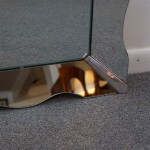Two-Way Mirrors in Dressing Rooms
The use of two-way mirrors, also known as one-way mirrors, in retail dressing rooms has been a topic of concern and discussion for years. These mirrors, designed to allow observation from one side while appearing reflective on the other, raise legitimate privacy concerns for shoppers. This article aims to explore the technical aspects of two-way mirrors, the legal implications of their use, and methods for identifying them.
How Two-Way Mirrors Work
Two-way mirrors rely on a partially reflective surface. A thin layer of metallic coating is applied to a piece of glass. This coating allows some light to pass through while reflecting the rest. The key to the illusion lies in the difference in light levels between the two sides. The observation side must be significantly darker than the dressing room side. The brighter light in the dressing room reflects off the mirrored surface back towards the shopper, making it appear like a regular mirror. Meanwhile, the observer on the darker side sees the light transmitted from the dressing room, effectively seeing through the glass.
Legality of Two-Way Mirrors in Dressing Rooms
The legality of using two-way mirrors in dressing rooms varies by jurisdiction. Some regions have specific laws prohibiting their use in areas where privacy is expected, while others rely on broader privacy legislation. It's crucial for retailers to understand and comply with local laws regarding surveillance and privacy. Failure to do so can result in legal action and damage to reputation.
Identifying a Two-Way Mirror
Several methods can help determine whether a mirror is a two-way mirror or a standard mirror. While none are foolproof, they can provide helpful clues. It's important to remember that these methods are not definitive, and if there is any doubt, it's best to err on the side of caution.
The Fingernail Test
One common method is the fingernail test. Place your fingernail against the surface of the mirror. If there is a gap between your fingernail and its reflection, it's likely a regular mirror. However, if the reflection touches your fingernail directly, there might be a second layer of glass present, indicating a potential two-way mirror. The gap is created by the thickness of the glass in a regular mirror. The absence of a gap could indicate that the reflective surface is applied to the front of the glass, possibly part of a two-way mirror construction.
The Lighting Test
The lighting test involves turning off the lights in the dressing room and shining a bright light (like a flashlight) at the mirror. If there is an observation space behind the mirror, the light might reveal it. This method works because the light penetrates the partially reflective surface, illuminating the hidden area behind.
The Observation Test
If possible, try to observe the area behind the suspected two-way mirror. Look for any signs of an observation room, such as darkened windows or unusual wall configurations. This may require checking adjacent rooms or hallways.
The Sound Test
Another method involves cupping your hands around your ears and placing them against the mirror. This can amplify sounds from the other side. If you hear muffled conversations or other noises, it could indicate the presence of an observation area.
Retailer Transparency and Best Practices
Retailers should be transparent with their customers regarding any surveillance practices. Clearly displayed signage informing customers of monitoring policies, including the use of cameras (if applicable), can foster trust and alleviate concerns. Avoiding the use of two-way mirrors in dressing rooms altogether is considered best practice and contributes to a more positive and comfortable shopping experience.
Privacy Expectations in Dressing Rooms
Customers have a reasonable expectation of privacy when using dressing rooms. This expectation is rooted in the fundamental right to privacy and personal dignity. Retailers have a responsibility to respect this right and ensure that their practices do not violate it. Building trust with customers is essential for long-term success, and respecting privacy plays a vital role in achieving this trust.
Alternatives to Two-Way Mirrors
Retailers seeking security measures have several alternatives to two-way mirrors. Visible security cameras, strategically placed and clearly marked, can deter theft and provide a sense of security without compromising customer privacy. Employing store personnel to monitor dressing room areas is another option. Open communication and clear policies about loss prevention strategies can create a secure environment while maintaining respect for customer privacy.

This Is Super Creepy I Know Will Always Check My Dressing Room Mirrors Two Way Mirror The More You Fun Facts

A Woman Discovered Two Way Mirror In This Bar S Bathroom Owner Says It There To Stay

How To Tell If A Mirror Is Two Way Or Not 8 Steps With Pictures

Acrylic Two Way Mirror Buy Precision Cut 2 Mirrors

How To Tell If A Mirror Is Two Way Or Not 8 Steps With Pictures S Hotel Mirrors

Unions Say Some S Here Use Two Way Mirrors In Dressing Rooms To Curb Rise Lifting The New York Times

How To Tell If A Mirror Is Two Way Or Not 8 Steps With Pictures

How To Spot A Two Way Mirror Snopes Com

Breaking Down The Business Case Of Smart Fitting Rooms Detego

Women Safety Difference Between Mirror And 2 Way Glass








